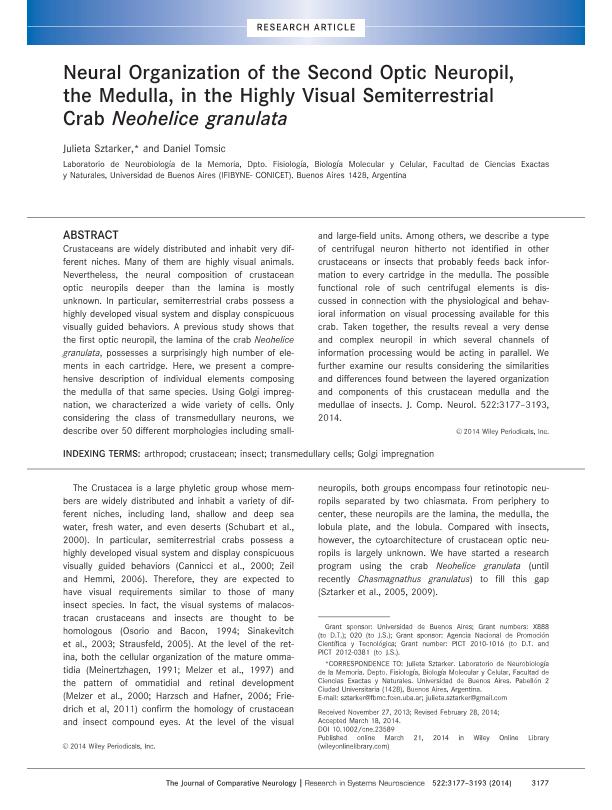Mostrar el registro sencillo del ítem
dc.contributor.author
Sztarker, Julieta

dc.contributor.author
Tomsic, Daniel

dc.date.available
2019-10-01T17:51:03Z
dc.date.issued
2014-12
dc.identifier.citation
Sztarker, Julieta; Tomsic, Daniel; Neural organization of the second optic neuropil, the medulla, in the highly visual semiterrestrial crab Neohelice granulata; Wiley-liss, Div John Wiley & Sons Inc; Journal Of Comparative Neurology; 522; 14; 12-2014; 3177-3193
dc.identifier.issn
0021-9967
dc.identifier.uri
http://hdl.handle.net/11336/84934
dc.description.abstract
Crustaceans are widely distributed and inhabit very different niches. Many of them are highly visual animals. Nevertheless, the neural composition of crustacean optic neuropils deeper than the lamina is mostly unknown. In particular, semiterrestrial crabs possess a highly developed visual system and display conspicuous visually guided behaviors. A previous study shows that the first optic neuropil, the lamina of the crab Neohelice granulata, possesses a surprisingly high number of elements in each cartridge. Here, we present a comprehensive description of individual elements composing the medulla of that same species. Using Golgi impregnation, we characterized a wide variety of cells. Only considering the class of transmedullary neurons, we describe over 50 different morphologies including small- and large-field units. Among others, we describe a type of centrifugal neuron hitherto not identified in other crustaceans or insects that probably feeds back information to every cartridge in the medulla. The possible functional role of such centrifugal elements is discussed in connection with the physiological and behavioral information on visual processing available for this crab. Taken together, the results reveal a very dense and complex neuropil in which several channels of information processing would be acting in parallel. We further examine our results considering the similarities and differences found between the layered organization and components of this crustacean medulla and the medullae of insects.
dc.format
application/pdf
dc.language.iso
eng
dc.publisher
Wiley-liss, Div John Wiley & Sons Inc

dc.rights
info:eu-repo/semantics/openAccess
dc.rights.uri
https://creativecommons.org/licenses/by-nc-sa/2.5/ar/
dc.subject
ARTHROPOD
dc.subject
CRUSTACEAN
dc.subject
GOLGI IMPREGNATION
dc.subject
INSECT
dc.subject
TRANSMEDULLARY CELLS
dc.subject.classification
Otros Tópicos Biológicos

dc.subject.classification
Ciencias Biológicas

dc.subject.classification
CIENCIAS NATURALES Y EXACTAS

dc.title
Neural organization of the second optic neuropil, the medulla, in the highly visual semiterrestrial crab Neohelice granulata
dc.type
info:eu-repo/semantics/article
dc.type
info:ar-repo/semantics/artículo
dc.type
info:eu-repo/semantics/publishedVersion
dc.date.updated
2019-09-30T18:51:29Z
dc.journal.volume
522
dc.journal.number
14
dc.journal.pagination
3177-3193
dc.journal.pais
Estados Unidos

dc.description.fil
Fil: Sztarker, Julieta. Consejo Nacional de Investigaciones Científicas y Técnicas. Oficina de Coordinación Administrativa Ciudad Universitaria. Instituto de Fisiología, Biología Molecular y Neurociencias. Universidad de Buenos Aires. Facultad de Ciencias Exactas y Naturales. Instituto de Fisiología, Biología Molecular y Neurociencias; Argentina
dc.description.fil
Fil: Tomsic, Daniel. Consejo Nacional de Investigaciones Científicas y Técnicas. Oficina de Coordinación Administrativa Ciudad Universitaria. Instituto de Fisiología, Biología Molecular y Neurociencias. Universidad de Buenos Aires. Facultad de Ciencias Exactas y Naturales. Instituto de Fisiología, Biología Molecular y Neurociencias; Argentina
dc.journal.title
Journal Of Comparative Neurology

dc.relation.alternativeid
info:eu-repo/semantics/altIdentifier/url/https://onlinelibrary.wiley.com/doi/abs/10.1002/cne.23589
dc.relation.alternativeid
info:eu-repo/semantics/altIdentifier/doi/https://doi.org/10.1002/cne.23589
Archivos asociados
